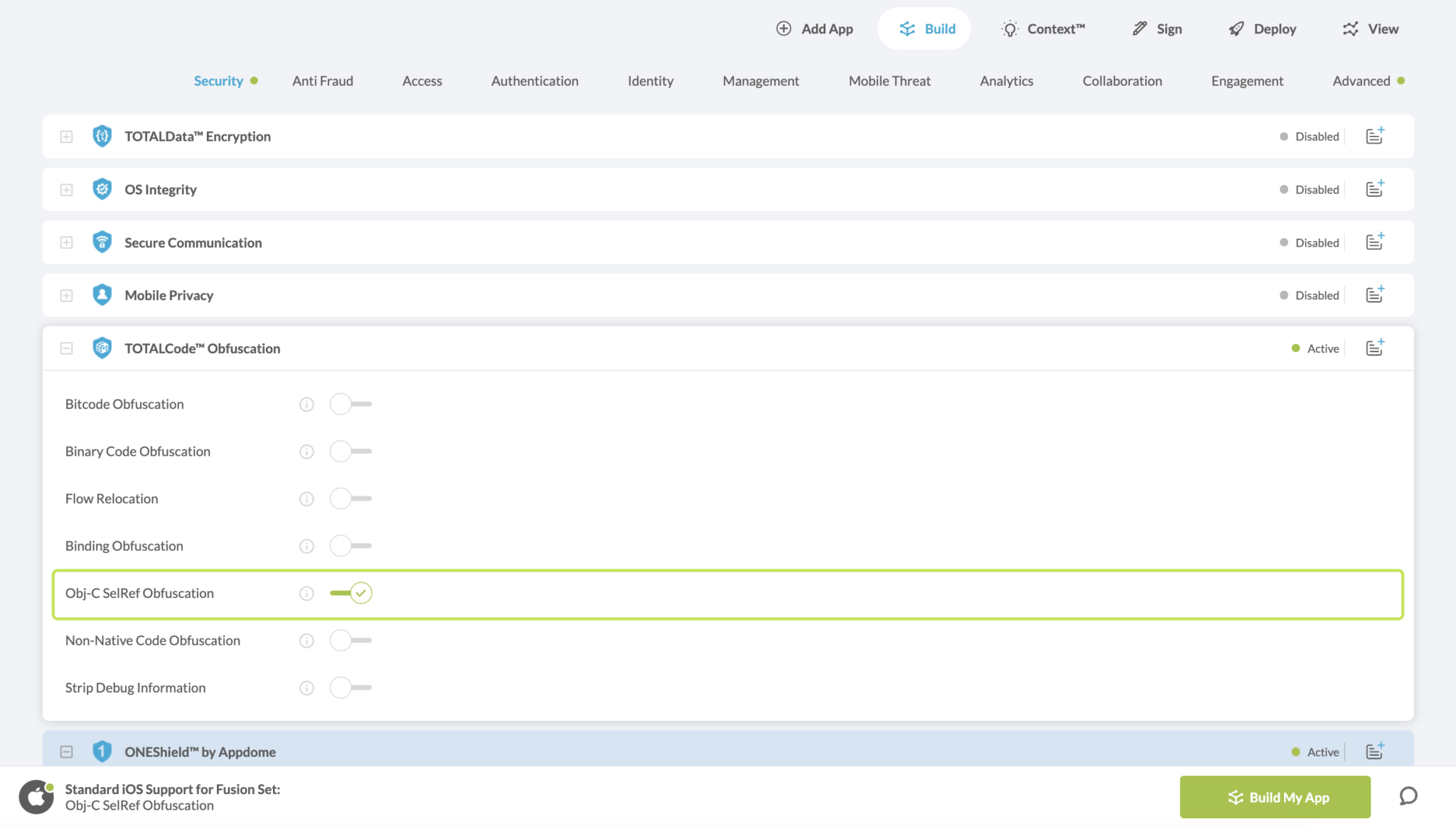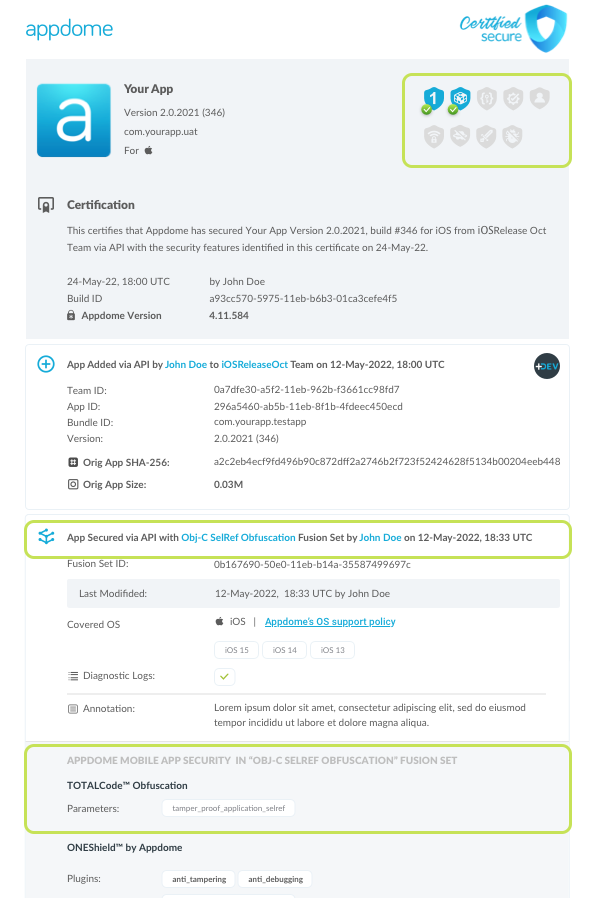iOS SelRef Obfuscation, Anti-Reversing in iOS Apps
Learn to Add SelRef Obfuscation in iOS apps, in mobile CI/CD with a Data-Driven DevSecOps™ build system.
What is Objective-C SelRef?
iOS applications run on Apple mobile devices within the Objective-C runtime. Because the runtime does not work with method names, when building iOS apps the class’s method name is converted into a selector that represents this method, and therefore acts as the link between the method name and its implementation in the app. This selector is referred to as a “SelRef” (Selector Reference) in the compiled binary. Using selectors has many benefits, such as reducing app size by storing only one ASCII representation of all methods that share the same name, as well as the ability to extend and override a specific method’s logic.
Why do developers need to obfuscate SelRefs in iOS apps?
Attackers use SelRef during static analysis and reverse engineering to gain a deep understanding of the inner workings of an iOS app. For example, determining which method is being called within a function is only possible by resolving the selRef being used to the method it is associated to. Furthermore, attackers can perform the opposite conversion, going from method names to it’s SelRef, to find all calls to method in question by finding all references to the SelRef. Obfuscating SelRef in the application binary prevents the attacker from performing these conversions, thereby significantly limiting the risk of reverse engineering.
Prerequisites for Using Obj-C SelRef Obfuscation:
To use Appdome’s mobile app security build system to Add SelRef Obfuscation , you’ll need:
- Appdome account (create a free Appdome account here)
- A license for Obj-C SelRef Obfuscation
- Mobile App (.ipa for iOS)
- Signing Credentials (see Signing Secure Android apps and Signing Secure iOS apps)
Add SelRef Obfuscation on iOS apps using Appdome
On Appdome, follow these 3 simple steps to create self-defending iOS Apps that Add SelRef Obfuscation without an SDK or gateway:
-
Upload the Mobile App to Appdome.
-
Upload an app to Appdome’s Mobile App Security Build System
-
Upload Method: Appdome Console or DEV-API
-
iOS Formats: .ipa
-
Obj-C SelRef Obfuscation Compatible With: Obj-C, C+, Java, Swift, Flutter, React Native, Unity, Xamarin, Cordova and more
-
-
Build the feature: Obj-C SelRef Obfuscation.
-
Building Obj-C SelRef Obfuscation by using Appdome’s DEV-API:
-
Create and name the Fusion Set (security template) that will contain the Obj-C SelRef Obfuscation feature as shown below:
-
Follow the steps in Sections 2.2.1-2.2.2 of this article, Building the Obj-C SelRef Obfuscation feature via Appdome Console, to add the Obj-C SelRef Obfuscation feature to this Fusion Set.
-
Open the Fusion Set Detail Summary by clicking the “...” symbol on the far-right corner of the Fusion Set, as shown in Figure 1 above, and get the Fusion Set ID from the Fusion Set Detail Summary (as shown below):

Figure 2: Fusion Set Detail Summary
Note: Annotating the Fusion Set to identify the protection(s) selected is optional only (not mandatory). -
Follow the instructions below to use the Fusion Set ID inside any standard mobile DevOps or CI/CD toolkit like Bitrise, App Center, Jenkins, Travis, Team City, Cirlce CI or other system:
-
Build an API for the app – for instructions, see the tasks under Appdome API Reference Guide
-
Look for sample APIs in Appdome’s GitHub Repository
-

Figure 1: Fusion Set that will contain the Obj-C SelRef Obfuscation feature
Note: Naming the Fusion Set to correspond to the protection(s) selected is for illustration purposes only (not required). -
-
Building the Obj-C SelRef Obfuscation feature via Appdome Console
To build the Obj-C SelRef Obfuscation protection by using Appdome Console, follow the instructions below.
-
Where: Inside the Appdome Console, go to Build > Security Tab > TOTALCode™ Obfuscation section.
-
When you select the Obj-C SelRef Obfuscation you'll notice that your Fusion Set you created in step 2.1.1 now bears the icon of the protection category that contains Obj-C SelRef Obfuscation

Figure 4: Fusion Set that displays the newly added Obj-C SelRef Obfuscation protection
-
Click Build My App at the bottom of the Build Workflow (shown in Figure 3).
-
Congratulations! The Obj-C SelRef Obfuscation protection is now added to the mobile app -
Using Appdome, there are no development or coding prerequisites to build secured iOS Apps by using Obj-C SelRef Obfuscation. There is no SDK and no library to code or implement in the app and no gateway to deploy in your network. All protections are built into each app and the resulting app is self-defending and self-protecting.
Releasing and Publishing Mobile Apps with Obj-C SelRef Obfuscation
After successfully securing your app by using Appdome, there are several available options to complete your project, depending on your app lifecycle or workflow. These include:
- Customizing, Configuring & Branding Secure Mobile Apps
- Deploying/Publishing Secure mobile apps to Public or Private app stores
- Releasing Secured Android & iOS Apps built on Appdome.
Related Articles:
If you have any questions, please send them our way at support.appdome.com or via the chat window on the Appdome platform.
Thank you!
Thanks for visiting Appdome! Our mission is to secure every app on the planet by making mobile app security easy. We hope we’re living up to the mission with your project.


